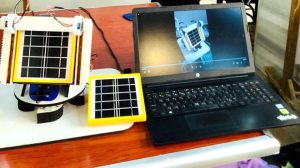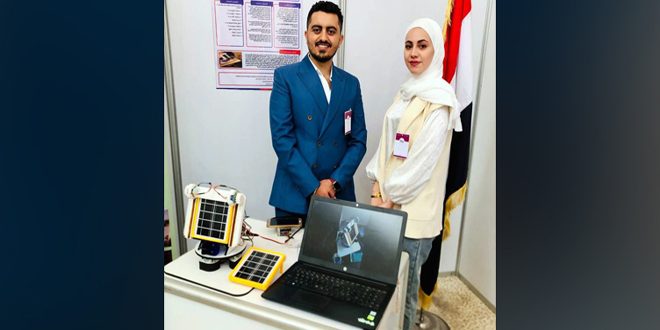Two engineers design a tracking, cooling and cleaning system for solar panels
Damascus, (ST) – In light of the increasing use of photovoltaic systems worldwide, and to obtain the largest possible energy from solar radiation and enhance the efficiency of panels, engineers Najeeb Al-Jassem and Rogina Ahmed designed a mobile solar tracking system.
Engs. Rogina and Naguib specializing in energy engineering said to SANA that the mechanism of operation of this system that they implemented is through the design of a solar tracking system, which makes the panels move towards the sun throughout the daylight hours, so that the rays remain perpendicular to the surface of the panel. It was also provided with a cleaning and cooling mechanism using dispersants thermal to increase the productivity and efficiency of the panels.
Eng. Rogina stated that the performance of the system is monitored in the event of a malfunction, a decrease in efficiency, or when the panels need to be cleaned, through an electronic application that sends messages to the mobile phone to alert the user of the status of the panels.
Rogina said that she and engineer Naguib sought to confront the difficulties that hindered the design of the system. They manufactured some basic parts using a 3D printer instead of installing expensive metal parts, and installed two motors to achieve balance with the movement of a mop cleaning the board.
 They also addressed the weak rotation of the motor due to the heavy weight of the board by installing a gearbox and gears with an appropriate conversion ratio.
They also addressed the weak rotation of the motor due to the heavy weight of the board by installing a gearbox and gears with an appropriate conversion ratio.
Meanwhile, Eng. Naguib said that this system increases the electrical capacity of the power panels by 75 percent, as it included an increase of 40 percent through the continuous movement of the panels, 15 percent through the solar panel cleaning system, and 20 percent through the cooling system, indicating that the new system it enables us to get the same power output with fewer panels.
Naguib pointed out that the system was tested in a high area for 12 days in all weather conditions – sunny – cloudy – rainy – dusty during the daylight hours, and the system showed good performance and high efficiency.
In turn, Sumaya Al-Rashed a doctor in the Department of Renewable Energies at the University of Aleppo and the project supervisor pointed out the importance of design because of its ability to overcome the most important problems that solar panels suffer from, especially in capturing rays for the longest possible period, as well as improving the performance of the panels and maintaining them for a longer period.
Dr. Al-Rashed pointed out the importance of supporting this type of project that secures our need for solar energy to secure electricity in light of the shortage of energy generated from fossil fuels. He indicated that when the project is implemented on larger panels, the economic feasibility will appear better.
This design won the first prize for the University of Aleppo during its participation in the sixth exhibition of distinguished student graduation projects and research, which was held by the Faculty of Mechanical and Electrical Engineering at the University of Damascus on the 5th of last November, in which 196 projects and applied research participated.
Raghda Sawas

